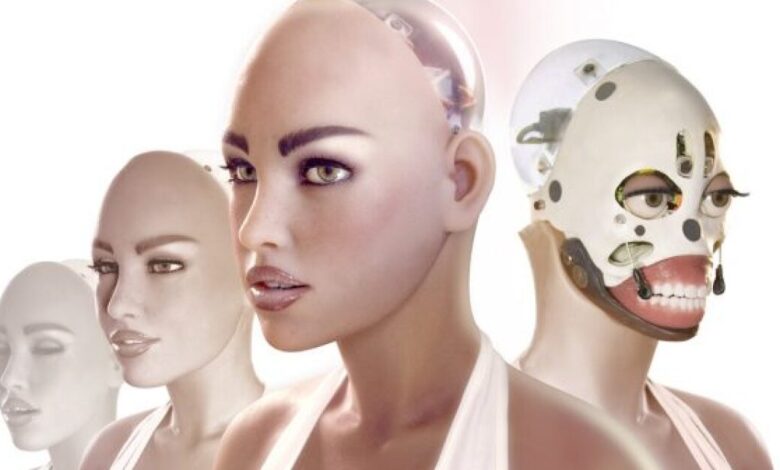The Rise Of The Sexbots

The sexbots are coming. Well, not literally, not yet anyway—but that’ll happen soon enough with further advances in the fields of robotics and artificial intelligence to the point that you would no longer be able to distinguish whether or not your sexbot was just faking it.
For those of you who haven’t made it past first base in the world of sexual machines and are asking, “Sexbot? What is this sexbot?” let me explain as clearly and couthly as possible.
A “sexbot” is a robot designed for humans to have sexual intercourse with. It is a machine engineered for sexual simulation and stimulation. If this sounds a bit mechanical and crass, it’s because, well, it sort of is. That being said, a major facet of human sexual intercourse is mechanical—so much so that prescribing tool analogies to our descriptions of it have become part of our popular cultural lexicon. (Don’t drill me on the particulars.)
While there are deep emotional, psychological, and spiritual dimensions to human sexuality, it is, at its core, a physical action. The fact is that most of us—excepting those conceived via artificial insemination or in vitro fertilization—were forged in the crucible of that action.
My purpose here is not to pass judgement on people’s sex lives nor their preferences or fetishes nor wade into the morass of a sexual morality debate. I’m a technologist after all, not a philosopher or a sex therapist.
With the technology of sexbots, we have introduced a variable into the system of human culture that taps into the very core of our limbic system, which runs our deepest and oldest programming.
As a technologist, it’s my obligation to inform you that sexbots are a rapidly emerging technology that will have a profound effect upon the future of human sexual relations and the further integration of robots into the fabric of everyday human life.
While sexbots are a fairly new phenomenon, the existence of man-made sexual devices has been around for a long time, beginning with the artificial phallus, the oldest of which was discovered in Germany in 2005. Made of siltstone and measuring in at 7.8” in length, it is estimated to be 28,000 years old. It was not, however, just a stone that happened to be phallus shaped. It was constructed of 14 individual fragments that were crafted together. Like other prehistoric tools, the world’s oldest artificial phallus was constructed by human hands for a specific purpose.
A technology is any tool or system that harnesses natural materials and phenomenon to serve a human purpose. An ancient siltstone phallus is a technology just as a modern-day sexbot is a technology. The major differences are found in the complexity of the technology being utilized.
Sexbots are increasingly complex technologies that combine advances in robotics and artificial intelligence. Currently, they are primitive but that is changing rapidly. The most advanced sexbot available on the market today is “Harmony”, created by Realbotix. Her lips move when she speaks. Her eyes blink. Her head tilts. It’s a bit freaky to watch and drops most people into a place referred to in robotics as the “uncanny valley”.
The term “uncanny valley” is used by roboticists to describe the unsettling feeling people get when they encounter an android (a humanoid robot) that closely resembles a human in many ways but is not convincingly realistic.
A human’s response to an android can be graphed with “human likeness” on the x-axis and “familiarity” on the y-axis. The uncanny valley is the deep trough created on that graph as human likeness and familiarity bottom out with “zombies” and then climbs toward 100 percent with real humans.
According to techtarget.com, “The uncanny valley is named for the way the viewer’s level of comfort drops as a simulation approaches, but does not reach, verisimilitude.”
Harmony’s AI robotic head is attached to a synthetic replica of a female body that can be custom designed. (Yes, there are anatomically male sexbots too, but female replicas are more popular.) Her response modes can be programmed via an accompanying smartphone app, enabling the most recent version of Harmony to utilize built-in sensors to respond to movement and touch with unique sounds and expressions.
“Does it make you sad about potentially replacing human relationships with a robot partner instead?” Katie Couric asked Realbotix founder and CEO, Matt McMullen, in a recent ABC interview.
“It’ll never happen,” McMullen said confidently. “It’s an alternative, not a replacement. It’s different.”
Different indeed but it’s going to make a difference.
Once a technology is introduced into human culture, it changes that culture. Human culture is a system and like any system, when you change a variable, you change the input. Change the input and you change the output. That is the nature of systems. Sometimes these outputs are known and expected. Other times they are unknown and have secondary and tertiary impacts that were not expected.
With the technology of sexbots, we have introduced a variable into the system of human culture that taps into the very core of our limbic system, which runs our deepest and oldest programming. With sexbots, we’re using our higher functioning cortex system to create a technology that hacks human sexuality, which could lead to some unintended consequences.
For example, maybe the human race doesn’t go extinct due to a fantastic catastrophe like nuclear war or an errant asteroid slamming into Earth. Maybe we’ll slowly self-select our extinction by no longer procreating because we’ve stopped having sex with other humans and instead are having sex with advanced AI robots that have climbed their way out of the uncanny valley and into our beds.
With the rise of advanced sexbots, we might truly be screwed.
Scott Dewing is a technologist, teacher, and writer. He lives with his family on a low-tech farm in the State of Jefferson.
You can read the full article from the source HERE.
-
Sale!

Aurora: Tender Sex Doll
Original price was: $2,799.00.$2,599.00Current price is: $2,599.00. Buy Now -
Sale!

Dominique: Thick Sex Doll
Original price was: $2,499.00.$2,199.00Current price is: $2,199.00. Buy Now -
Sale!

Auburn: Red Head Sex Doll
Original price was: $2,199.00.$1,899.00Current price is: $1,899.00. Buy Now



